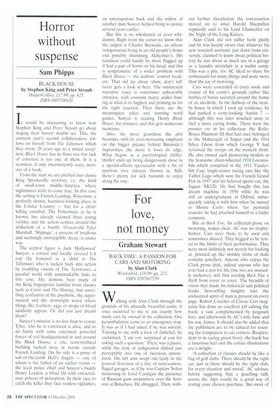For love, not money
Graham Stewart
BACK FIRE: A PASSION FOR CARS AND MOTORING by Alan Clark Weidenfeld, .£18.99, pp. 212, ISBN 0297607359 Walking with Alan Clark through the grounds of his absurdly beautiful castle, it once occurred to me to ask exactly how many cars he owned in his collection. Our perambulation came to an emergency stop. It was as if I had asked if he was solvent. Turning to me with a look of disbelief, he exclaimed, 'I am very surprised at you for asking such a question.' There was a pause, while the look of indignation shifted just perceptibly into one of facetious amusement. His left arm swept out lazily in the general direction of a line of semi-camouflaged garages, as if he was Captain Nolan motioning to Lord Cardigan the presence of Russian guns somewhere over the horizon at Balaclava. He shrugged. Then, with out further elucidation, the conversation moved on to what Harold Macmillan reputedly said to his Lord Chancellor on the Night of the Long Knives.
Alan Clark did not suffer fools gladly and he was keenly aware that whatever his new research assistant, just down from university, claimed to know about political history he was about as much use in a garage as a laundry attendant in a nudist camp. This was a pity. for AC liked to share his enthusiasm for many things and none more than the joy of motoring.
Cars were concealed in every nook and cranny of his castle's grounds rather like bottles of booze secreted around the home of an alcoholic. In the hallway of the nearby house in which I took up residence, he had parked a sorry-looking Austin 7 — although this was later winched away to find a more caring home. There were the premier cni in his collection: the RollsRoyce Phantom III that had once belonged to the Maharajah of Jaipur and the 1914 Silver Ghost from which George V had reviewed the troops on the western front. He also owned such pioneering models as the fearsome chain-wheeled 1910 Locomobile which competed in the 1911 Vanderbilt Cup, single-seater racing cars like the Talbot Lago which won the French Grand Prix in 1947 and his beloved sports car, the Jaguar X1020. He had bought this last dream machine in 1950 while he was still an undergraduate at Oxford, subsequently taking it with him when he moved to Monte Carlo where 'for personal reasons' he had attached himself to a ballet company.
But as Back Fire, his collected prose on motoring, makes clear, AC was no trophyhunter. Cars were there to be used and sometimes abused. They begged to be tested to the limits of their performance. They were most definitely not merely for looking at, prizzied up like twinkly items of male costume jewellery. Anyone who enjoys the Clark prose style, indeed anyone who has ever had a zest for life (the two are mutually inclusive), will find reading Back Fire a thrill from cover to cover, The breadth of vision that made his historical and political books best-selling insights into the undaunted spirit of man is present on every page. Robert Coucher of Classic Cars magazine has done an excellent job editing the book; a task complemented by poignant foreand afterwords by AC's wife Jane and his son, James. It should also be added that the publishers are to be saluted for resisting the temptation to cut corners. Resplendent in its racing green livery, the book has a luxurious feel and the colour illustrations are a delight.
'A collection of classics should be like a bag of golf clubs. There should be the right car, just as there should be the right club, for every situation and mood,' AC advises, before suggesting that a gruelling rally across the Alps would be a good way of testing your chosen purchase. But most of all, the message he proclaims is 'always buy for love, not money'. It is this endearing hymn that makes Back Fire not only an essential read for the dedicated motormaniac, but also a joy for the ambling boulevardier whose reflection, be assured, speedily receded into an insignificant dot on the great man's wing mirror.



























































































 Previous page
Previous page